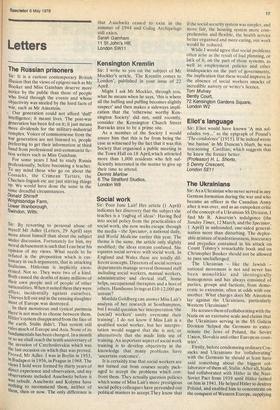The Ukrainians
Sir: As a Ukrainian who never served in any German formation during the war and who became an officer in the Canadian Army after it was over, and as an outspoken critic of the concept of a Ukrainian SS Division, I find Mr R. Ainsztein's indulgence (the Sunday Times 12 March and the Spectator, 1 April) in unfounded, one-sided generalisation more than disturbing. The deplorable mixture of tendentiousness, inaccuracy and prejudice contained in his attack on Count Tolstoy's remarkable book and on Christopher Booker should not be allowed to pass unchallenged.
The Ukrainian — like the Jewish — national movement is not and never has been monolithic and ideologically homogenous and has always consisted of parties, groups and factions, from democratic to extremist, often at odds with one another. What charges does Mr Ainsztein lay against the Ukrainians, particularly Western Ukrainians?
He accuses them of collaborating with the Nazis on an extensive scale and claims that the Ukrainians serving in the SS Galicia Division 'helped the Germans to exterminate the Jews of Poland, the Soviet Union, Slovakia and other European countries'.
Firstly, before condemning ordinary Cossacks and Ukrainians for 'collaborating' with the Germans he should at least have said something about the biggest collaborator of them all, Stalin. After all, Stalin had collaborated with Hitler in the Nazi Soviet Pact from 1939 until Hitler turned on him in 1941. He helped Hitler to destroy Poland, and enabled him to concentrate on the conquest of Western Europe, supplying the Wehrmacht and the Luftwaffe (whose main task in 1940 was to destroy England) With an enormous amount of oil, minerals and precious raw materials. It was precisely at this time, when both the Soviet Union and Communists everywhere were Hitler's Obliging allies, that almost 40,000 Ukrainians volunteered for the Canadian Armed Forces.
Secondly, most Ukrainians had no reason at all to fight for Stalin and his brand of barbaric Communism, and every reason to °PPose him. Moscow's genocidal policies Connected with the forced collectivisation of land resulted in the death by premeditated and organised starvation of over SIX million Ukrainian peasants in 1932-33. This destruction of Ukrainian peasantry was followed by an extensive pogrom of the Ukrainian cultural elite in the mid-'thirties. When Hitler attacked the Soviet Union on 22 June 1941 there were only two battalions of Ukrainians in German uniforms ('Nachtigall' and `Roland'). But when the Germans `liberated' Lvov at the end of that Month they found over three thousand badly mutilated bodies of Ukrainian prisoners executed in a hurry by the retreating Soviet secret police.
If softie Ukrainians joined the Nazis and
are known to have behaved badly, others —
Lm the head of the Ukrainian Catholic' Church, Metropolitan A. Sheptytsky, to hundreds of ordinary people —were risking their lives daily by sheltering the Jews and helping them or organising an anti-German underground. There are plenty of published Jewish testimonies to confirm this, and even such a Ultrainophobe as Mr Ainsztein cannot deny their existence. On the other hand many Ukrainians simply believed that Only Germany was capable of destroying Bolshevism under which they had suffered SO terribly. Finally, the Ukrainians produced only one SS Division. Nothing spectacular for a nation of over forty million of whom about Six million can be described as Western Ukrainians. It is reasonable to assume that many Western Ukrainians who joined the SS Division Galicia (the organisation of the bivision began in April 1943 and its training in July 1943) may have been politically naive or too optimistic in trying to create a nucleus of Ukrainian armed forces, but they were certainly not murderers of Jews. And for two obvious reasons: (1) by the second half of 1943, not to speak of 1944, most
aSt European Jews had already met their tragic fate in the gas chambers and death earn. Ps and there were only insignificant numbers of survivors, and (2) the Division WaS not a police but a front-line formation. Since its chief goal was to fight against Soviet Communism, the Division was to be used only on the Eastern front, never against the Western Allies.
Sent to the Eastern Front in June 1944 it as badly mauled by the greatly superior rorces of the advancing Soviet Army in the third week of July near Brody in Galicia: of a total strength of 11,000 there were only 3,000 survivors. Consequently, it took months to reorganise the Division. In October of that year some combat groups of the Division took part in the suppression of the abortive uprising in Slovakia that was inspired and organised by the Soviets. From February 1945 the Division fought in Styria and in Slovenia against the Soviet Army and against Tito's partisans, before surrendering to the British at the beginning of May, 1945. Both in Slovakia and in Slovenia the Division managed to remain on friendly terms with the local population.
Before Mr Ainsztein ventures again into the complexities of East European history he should at least familiarise himself with elementary and generally known facts. Constantine Zelenko Chairman, Ukrainian Democratic Alliance, 23 Constantine Road, London NW3







































 Previous page
Previous page